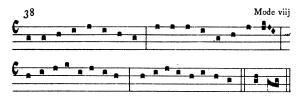Several things are conspiring to make me think about chant this morning. I’ve been splitting the Sarum hymn tunes into discrete jpeg files—like this one:
suitable for for use at Matins with Aurora lucis utilat and Lauds with Sermone blando Angelus. Too, at breakfast my Shuffle turned up the Enigma track that samples the Kyrie from the Missa Orbis Factor. Furthermore, I was looking at my blog stats. I get a lot of hits from Office hymn titles or searches for the Liber usualis.
One of the most common, though, is “Liber Usualis modern notation”. If you came here through this search term, I’ll make a quick comment on this topic. I don’t have one here and you’re not likely to find one. Why? Well—it’s about time economies. It would take an awful lot of time to translate the notation from the Liber into modern notation and the genuine fact is that the modern notation version would be inherently inaccurate because of the differences between modern music and chant. Even modern chant notation wouldn’t really do the trick.
So, that’s one half of the time economy; it would take a lot of time to produce it and the result would be imperfect. Now—here’s the other part. Chant notation only looks intimidating; it can be learned quite easily. Once learned, you can use it to read all sorts of things that go beyond the Liber. If you want to learn, I’d recommend starting with this excellent introduction, then download the Liber usualis, and go to your cd collection. If you have some basic chant cds—like “Chant” and “Chant II” from de Silos produced a few years back—cue a track, locate the chant in the Liber, and sing along. Start with the simple, then go from there. And look here for links to more introductions, scores, and audio files.

